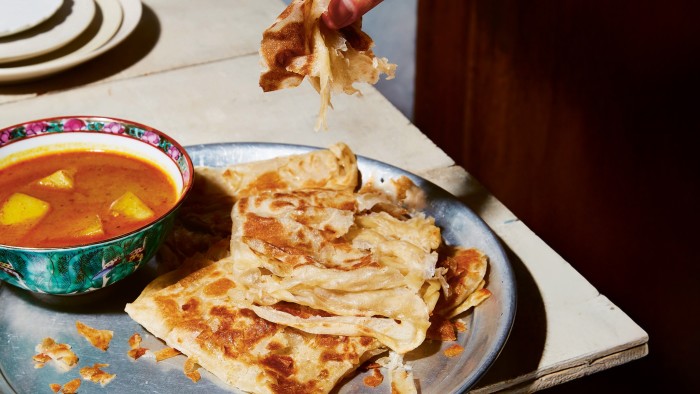Unlock the Editor’s Digest for free
Roula Khalaf, Editor of the FT, selects her favourite stories in this weekly newsletter.
It’s been more than 10 years since the first Roti King opened in a basement in Euston and the restaurant still attracts big queues. People come to the original branch or the three others that have sprung up in Battersea, Waterloo and Spitalfields for Malaysian staples such as nasi goreng, beef rendang and kari laksa. But it would be remiss of any customer not to order their signature namesake roti canai, too.
These flaky, fluffy, buttery flatbreads are the ultimate street food offering in Malaysia, where they’re eaten throughout the day but particularly for breakfast. Similar to Indian paratha and thought to derive from Kerala or Chennai in south India, roti canai (pronounced cha-nigh) were recently voted fourth best bread by food and drink website TasteAtlas. Their rise in popularity in the UK, however, is in large part due to Roti King and its owner Sugen Gopal, a master roti maker.
Before he opened Roti King as a restaurant in 2014, the Malaysian-born chef had developed a loyal following among the Malaysian diaspora. These days it’s rare to find him making rotis except at special events. But his version of the dish is available at Roti King and its sister chain Gopal’s Corner, where across nine sites at least 6,500 rotis are served each day. “A good roti chef can make about a hundred an hour,” he tells me.
For a long time Malaysian cooks were reluctant to share their recipes. “The dish is considered ‘sacred’,” wrote Norman Musa in his 2016 cookbook Amazing Malaysian (Square Peg, £28). “I asked for it many times, but no one would tell me.” It’s a big deal, then, that Gopal is publishing his recipe for the first time with a step-by-step guide in his new cookbook Roti King: Classic and Modern Malaysian Street Food (Quadrille, £18.99).

Sambal Shiok: The Malaysian Cookbook by Mandy Yin (Quadrille, £26)

Roti King: Classic and Modern Malaysian Street Food by Sugen Gopal (Quadrille, £18.99)
Like many recipes for roti canai, it’s straightforward in its list of ingredients and a little less straightforward in its methodology. To make 10 roti, you need 500g plain flour, one tbsp condensed milk, two tsp salt, two tsp caster sugar and one tbsp softened butter or margarine (with extra butter and vegetable oil for coating the dough balls as they rest). Other recipes include coconut water and egg. Mandy Yin’s recipe from her 2021 book Sambal Shiok (Quadrille) uses only flour, water, salt, sugar, oil and baking powder.
The ingredients are worked into a dough, rested, divided into balls and rested again. Then comes the tricky part: turning the balls into thin, flat rotis. Yin suggests using a rolling pin, which is the easiest option. I relish the challenge of Gopal’s method, which involves slapping the dough. As Gopal explains in his book, he mastered this more traditional technique when he was 14 years old working after school at his parents’ restaurant in Ipoh, Malaysia. It’s not easy. I met Gopal at the Waterloo branch of Roti King for a tutorial, and even standing next to him I needed him to repeat the process several times.

We started with ready-rested dough balls. On an oiled surface, we gently stretched the dough with the heels of our palms. Then we slapped it. Gopal made me practise (the same way he had as a 14-year-old) with a damp towel. I hooked my left thumb under one side and slid the fingers of my right hand under the other then lifted, swirled and slapped the towel back down.
When it came to replicating this with oily dough, I mostly ended up with a torn, sticky mess. Gopal slapped the dough with the finesse of a pizzaiolo tossing a crust or a bullfighter swirling a cape. It was fluid and effortless. What resulted was a large, thin, translucent sheet that he folded into a square, lifted from the centre and dropped into a crumpled round. A moment later, it went on the hotplate. There it crackled and was flipped before coming off golden and brown in spots, for the final step: a sharp clap from the side (like plumping a pillow) which sent up a puff of steam like a smoke signal and turned the flatbread into a domed fluffy roti.

Julie Lin is the Malaysian-Scottish co-founder of Gaga restaurant in Glasgow and considers roti canai her “number one dish of all time”. But when I asked why she hadn’t included the dish in her upcoming debut cookbook Sama Sama (Ebury), she told me she wanted the recipes to be accessible and roti canai was just too hard. After following Gopal’s method, I know what she means. Even Yin’s version – the simplest I could find – was by her own admission “a faff” for the amount of time and preparation required. “It’s not something you would attempt every day,” she tells me.
In his book Gopal offers this pep talk: “Please don’t be put off by the lengthy instructions . . . before you know it, you’ll be making roti canai fit for a roti king or queen!” It’s about embracing the effort and embracing the results. My roti canai were nothing compared to Gopal’s. But even my duds were salvageable and tasted great with curry.




